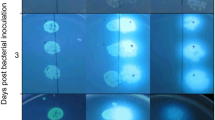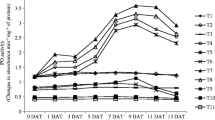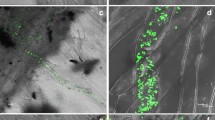Abstract
The aim of the study has been to determine the protection effect of brassinosteroid (BR27) in oilseed rape cotyledons against infection by an incompatible wild type of, a hypersensitive response mutant of and saprophytic Pseudomonas bacteria. In this paper, membrane permeability, PSII efficiency and metabolic activity were analysed. The following strains of Pseudomonans were used: P. syringae pv. syringae (Ps), P. syringae pv. syringae hrcC mutant (Pm) and P. fluorescence (Pf). The study was carried out using two cultivars of spring oilseed rape (Brassica napus L.): ‘Licosmos’ and ‘Huzar’. Pre-treatment of cotyledons with BR27 caused about 50–70% increase in ion leakage for both cultivars. However, BR27 significantly decreased ion leakage from cotyledons inoculated with Ps in both cultivars. Infection with Ps and Pf caused disturbances of energy flow in PSII by lowering its efficiency in rape cotyledons. We noted insignificant impact of 24-epibrassinolide on PSII efficiency if compared to absolute control, but generally it had a positive effect in plants infected with bacteria. The values of heat flow in all treatments, except for cotyledons infected with Ps, decreased during 20 h after inoculation. However, the curves of heat flow for Ps-infected cotyledons showed a completely different pattern with at least two peaks. BR27 pre-treated cotyledons infected with Ps had higher heat flow in comparison to Ps infected ones. BR27 treatment did not change specific enthalpy of cotyledon growth (Δgh) for both cultivars if compared with absolute control. However, infection with Ps markedly increased Δgh values by about 200% for both cultivars. We suggested protective action of BR27 in oilseed rape cotyledons after bacterial infection with Pseudomonas.


Similar content being viewed by others
Abbreviations
- AC:
-
Absolute control
- ABS:
-
Energy absorption
- BRs:
-
Brassinosteroids
- BR27 :
-
24-Epibrassinolide
- cfu:
-
Colony forming unit
- DIo:
-
Energy dissipation
- ETo:
-
Energy flux for electron transport
- Fv/Fm:
-
Maximum quantum yield of PSII
- HR:
-
Hypersensitive response
- Ps :
-
Pseudomonas syringae pv. syringae
- Pm :
-
Pseudomonas syringae pv. syringae hrcC mutant
- Pf :
-
Pseudomonas fluorescence
- RCs:
-
PSII reaction centres
- TRo:
-
Energy flux for trapping
- Δgh :
-
Specific enthalpy of growth
References
Grove MD, Spencer GF, Rohwedder WK, Mandawa N, Worley JF, Warthen JD, Steffens GL, Flippen-Anderson JL, Cook JC. Brassinolide, a plant growth-promoting steroid isolated from Brassica napus pollen. Nature. 1979;281:216–7.
Bajguz A, Tretyn A. The chemical characteristic and distribution of brassinosteroids in plants. Phytochemistry. 2003;62:1027–46.
Wang ZY, Seto H, Fujioka S, Yoshida S, Chory J. BRI1 is a critical component of a plasma-membrane receptor for plant steroids. Nature. 2001;410:380–3.
Symons GM, Ross JJ, Jager CE, Reid JB. Brassinosteroid transport. J Exp Bot. 2008;59:17–24.
Janeczko A, Biesaga-Kościelniak J, Oklešt’ková J, Filek M, Dziurka M, Szarek-Łukaszewska G, Kościelniak J. Role of 24-epibrassinolide in wheat production: physiological effects and uptake. J Agron Crop Sci. 2010;196:311–21.
Janeczko A, Swaczynová J. Endogenous brassinosteroids in wheat treated with 24-epibrassinolide. Biol Plant. 2010;54:477–82.
Zullo MAT, Kohout L. Semisystematic nomenclature of brassinosteroids. Plant Growth Regul. 2004;42:15–28.
Iwasaki T, Shibaoka H. Brassinosteroids act as regulators of tracheary-element differentiation in isolated Zinnia mesophyll cells. Plant Cell Physiol. 1991;32:1007–14.
Ramraj VM, Vyas BN, Godrej NB, Mistry KB, Swami BN, Singh N. Effects of 28-homobrassinolide on yields of wheat, rice, groundnut, mustard, potato and cotton. J Agric Sci. 1997;128:405–13.
Hu Y, Bao F, Li J. Promotive effect of brassinosteroids on cell division involves a distinct CycD3-induction. Plant J. 2000;24:693–701.
Zullo MAT, Adam G. Brassinosteroid phytohormones—structure, bioactivity and applications. Braz J Plant Physiol. 2002;14:83–121.
Fariduddin Q, Hasan SA, Ali B, Hayat S, Ahmad A. Effect of modes of application of 28-homobrassinolide on mung bean. Turk J Biol. 2008;32:17–21.
Bajguz A, Hayat S. Effects of brassinosteroids on the plant responses to environmental stresses. Plant Physiol Biochem. 2009;47:1–8.
Volynets AP, Pschenichnaya LA, Manzhelesova NE, Morozik GV, Khripach VA. The nature of protective action of 24-epibrassinolide on barley plants. Proc Plant Growth Regul Am Soc. 1997;24:133–7.
Khripach VA, Zhabinskii VN, de Groot AE. Twenty years of brassinosteroids: steroidal plant hormones warrant better crops for the XXI century. Ann Bot. 2000;86:441–7.
Krishna P. Brassinosteroid-mediated stress responses. J Plant Growth Regul. 2003;22:289–97.
Nakashita H, Yasuda M, Nitta T, Asami T, Fujioka S, Arai Y, Sekimata K, Takasuto S, Yamaguchi I, Yoshida S. Brassinosteroid functions in a broad range of disease resistance in tobacco and rice. Plant J. 2003;33:887–98.
Heath MC. Hypersensitive response-related death. Plant Mol Biol. 2000;44:321–34.
Chou H-M, Bundock N, Rolfe SA, Scholes JD. Infection of Arabidopsis thaliana leaves with Albugo candida (white blister rust) causes a reprogramming of host metabolism. Mol Plant Pathol. 2000;1:99–113.
Berger S, Papadopoulos M, Schreiber U, Kaiser W, Roitsch T. Complex regulation of gene expression, photosynthesis and sugar levels by pathogen infection in tomato. Physiol Plant. 2004;122:419–28.
Bonfig KB, Schreiber U, Gabler A, Roitsch T, Berger S. Infection with virulent and avirulent P. syringae strains differentially affects photosynthesis and sink metabolism in Arabidopsis leaves. Planta. 2006;225:1–12.
Janeczko A, Tóbias I, Skoczowski A, Dubert F, Gullner G, Barna B. Bacterial infection and pretreatment with 24-epibrassinolide markedly affect the heat emission and membrane permeability of rape cotyledons. Thermochim Acta. 2007;458:88–91.
Deng W-L, Preston G, Collmer A, Chang Ch-J, Huang H-Ch. Characterization of the hrpC and hrpRS operons of Pseudomonas syringae pathovars syringae, tomato, and glycinea and analysis of the ability of hrpF, hrpG, hrcC, hrpT, and hrpV mutants to elicit the hypersensitive response and disease in plants. J Bacteriol. 1998;180:4523–31.
Szatmári Á, Ott PG, Varga GJ, Besenyei E, Czelleng A, Klement Z, Bozsó Z. Characterisation of basal resistance (BR) by expression patterns of newly isolated representative genes in tobacco. Plant Cell Rep. 2006;25:728–40.
Barna B, Adám A, Király Z. Juvenility and resistance of a superoxide-tolerant plant to diseases and other stresses. Naturwissenschaften. 1993;80:420–2.
Strasser RJ, Srivatava A, Tsimilli-Michael M. The fluorescence transient as a tool to characterize and screen photosynthetics samples. In: Yunus M, Pathre U, Mohaty P, editors. Probing photosynthesis: mechanism, regulation and adaptation. London: Taylor and Francis; 2000. p. 445–83.
Janeczko A, Gullner G, Skoczowski A, Dubert F, Barna B. Effects of brassinosteroid infiltration prior to cold treatment on ion leakage and pigment contents in rape leaves. Biol Plant. 2007;51:355–8.
Zhang Z, Ramirez J, Reboutier D, Brault M, Trouverie J, Pennarun AM, Amiar Z, Biligui B, Galagovsky L, Rona JP. Brassinosteriods regulate plasma membrane anion channels in addition to proton pumps during expansion of Arabidopsis thaliana cells. Plant Cell Physiol. 2005;46:1494–504.
Dhaubhadel S, Browning KS, Gallie DR, Krishna P. Brassinosteroid functions to protect the translational machinery and heat-shock protein synthesis following thermal stress. Plant J. 2002;29:681–91.
Xia XJ, Wang YJ, Zhou YH, Tao Y, Mao WH, Shi K, Asami T, Chen Z, Yu JQ. Reactive oxygen species are involved in brassinosteroid-induced stress tolerance in cucumber. Plant Physiol. 2009;150:801–14.
Ali B, Hasana SA, Hayat S, Hayat Q, Yadav S, Fariduddin Q, Ahmad A. A role for brassinosteroids in the amelioration of aluminium stress through antioxidant system in mung bean. Environ Exp Bot. 2008;62:153–9.
Vlašánková E, Kohut L, Klemš M, Eder J, Reinöhl V, Hradilik J. Evaluation of biological activity of new synthetic brassinolide analogs. Acta Physiol Plant. 2009;31:987–93.
Pogány M, Koehl J, Heiser I, Elstner EF, Barna B. Juvenility of tobacco induced by cytokinin gene introduction decreases susceptibility to Tobacco necrosis virus and confers tolerance to oxidative stress. Physiol Mol Plant Pathol. 2004;65:39–47.
Barna B, Smigocki AC, Baker JC. Transgenic production of cytokinin suppresses bacterially induced hypersensitive response symptoms and increases antioxidative enzyme levels in Nicotiana spp. Phytopathology. 2008;98:1242–7.
Shan L, He P, Li J, Heese A, Peck SC, Nürnberger T, Martin GB, Sheen J. Bacterial effectors target the common signaling partner BAK1 to disrupt multiple MAMP receptor-signaling complexes and impede plant immunity. Cell Host Microbe. 2008;4:17–27.
Sasse JM. Physiological actions of brassinosteroids: an update. J Plant Growth Regul. 2003;22:276–88.
Janeczko A, Filek W, Biesaga-Kościelniak J, Marcińska L, Janeczko Z. The influence of animal sex hormones on the induction of flowering in Arabidopsis thaliana: comparison with the effect of 24-epibrassinolide. Plant Cell Tissue Organ Cult. 2003;72:147–51.
Yu JQ, Huang LF, Hu WH, Zhou YH, Mao WH, Ye SF, Nogues S. A role of brassinosteroids in the regulation of photosynthesis in Cucumis sativus. J Exp Bot. 2004;55:1135–43.
Janeczko A, Kościelniak J, Pilipowicz M, Szarek-Łukaszewska G, Skoczowski A. Protection of winter rape photosystem II by 24-epibrassinolide under cadmium stress. Photosynthetica. 2005;43:293–8.
Wilen RW, Sacco M, Gusta LV, Krishna P. Effects of 24-epibrassinolide on freezing and thermotolerance of bromegrass (Bromus inermis) cell cultures. Physiol Plant. 1995;95:195–202.
Dhaubhadel S, Chaudhary S, Dobinson KF, Krishna P. Treatment with 24-epibrassinolide, a brassinosteroid, increases the basic thermotolerance of Brassica napus and tomato seedlings. Plant Mol Biol. 1999;40:333–42.
Mazorra LM, Núñez M. Brassinosteroid analogues differentially modify peroxidase activity, superoxide dismutase activity and protein content in tomato seedlings. Cult Tropic. 2000;21:29–33.
Mazorra LM, Núñez M, Hechavarria M, Coll F, Sanchez-Blanco MJ. Influence of brassinosteroids on antioxidant enzymes activity in tomato under different temperatures. Biol Plant. 2002;45:593–6.
Singh I, Shono M. Physiological and molecular effects of 24-epibrassinolide, a brassinosteroid on thermotolerance of tomato. Plant Growth Regul. 2005;47:111–9.
Pociecha E, Janeczko A. Oddziaływanie 24-epibrasinolidu i stresu wysokiej temperatury na aktywność enzymów antyoksydacyjnych i rozwój roślin jęczmienia jarego. Zesz Probl Post Nauk Rol. 2008;524:83–93. (in Polish with English abstract).
Criddle RS, Fontana AJ, Rank DR, Paige L, Hansen D, Breidenbach RW. Simultaneous measurement of metabolic heat rate, CO2 production, and O2 consumption by microcalorimetry. Anal Biochem. 1991;194:413–7.
Feng W, Ning L, Daley LS, Moreno Y, Azarenko A, Criddle S. Theoretical fitting of energetics of CAM path to calorimetric data. Plant Physiol Biochem. 1994;32:591–8.
Płażek A, Rapacz M. The intensity of respiration and heat emission from seedlings of Festuca pratensis (Hud.) and Hordeum vulgare L. during pathogenesis caused by Bipolaris sorokiniana (Sacc.) Shoem. Acta Physiol Plant. 2000;22:25–30.
Sigstad EE, Prado FE. A microcalorimetric study of Chenopodium quinoa Willd seed germination. Thermochim Acta. 1999;326:159–64.
Stokłosa A, Janeczko A, Skoczowski A, Kieć J. Isothermal calorimetry as a tool for estimating resistance of wild oat (Avena fatua L.) to aryloxyphenoxypropionate herbicides. Thermochim Acta. 2006;441:203–6.
Schabes FI, Sigstad EE. A calorimetric study of the allelopathic effect of cnicin isolated from Centaurea diffusa Lam. on the germination of soybean (Glicine max) and radish (Raphanus sativus). Thermochim Acta. 2007;458:84–7.
Troć M, Skoczowski A, Barańska M. The influence of sunflower and mustard leaf extracts on the germination of mustard seeds. J Therm Anal Calorim. 2009;95:727–30.
Wadsö I. Trends in isothermal microcalorimetry. Chem Soc Rev. 1997;26:79–86.
Author information
Authors and Affiliations
Corresponding author
Rights and permissions
About this article
Cite this article
Skoczowski, A., Janeczko, A., Gullner, G. et al. Response of brassinosteroid-treated oilseed rape cotyledons to infection with the wild type and HR-mutant of Pseudomonas syringae or with P. fluorescence . J Therm Anal Calorim 104, 131–139 (2011). https://doi.org/10.1007/s10973-010-1204-z
Published:
Issue Date:
DOI: https://doi.org/10.1007/s10973-010-1204-z




